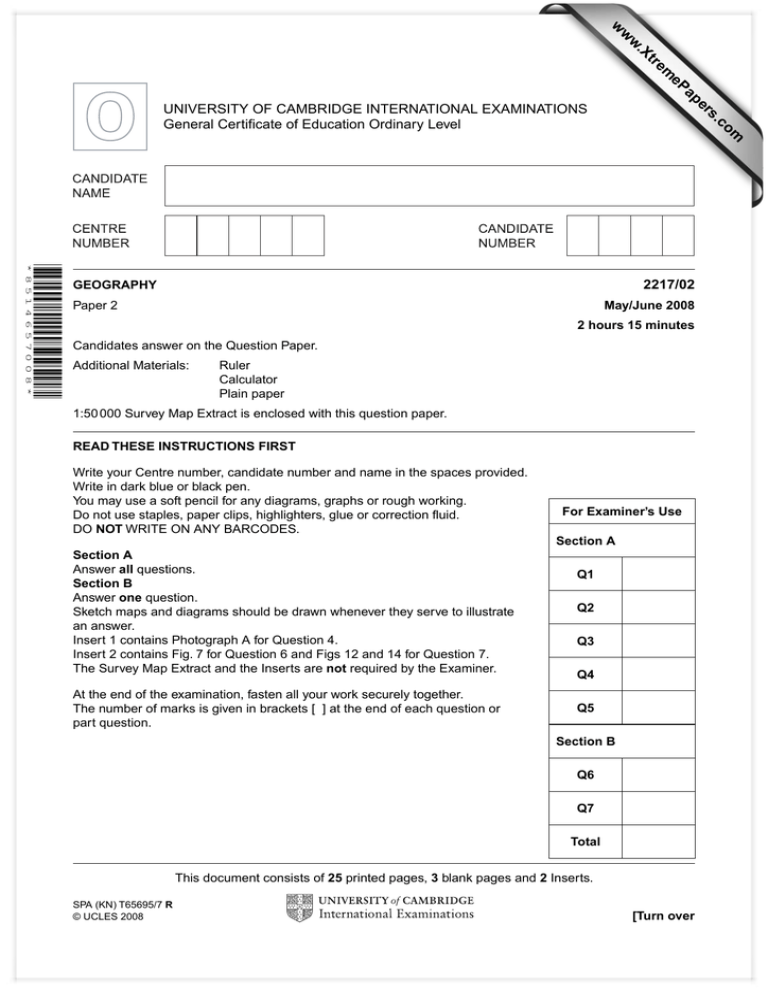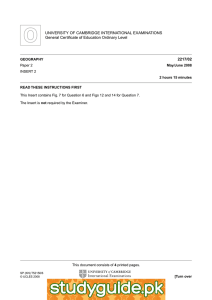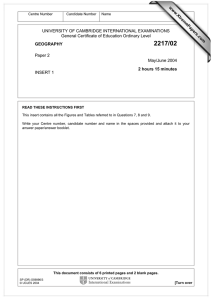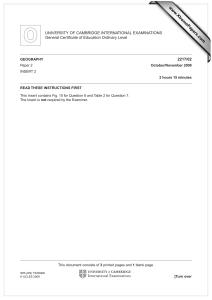
w
w
ap
eP
m
e
tr
.X
w
om
.c
s
er
UNIVERSITY OF CAMBRIDGE INTERNATIONAL EXAMINATIONS
General Certificate of Education Ordinary Level
*8514657008*
2217/02
GEOGRAPHY
Paper 2
May/June 2008
2 hours 15 minutes
Candidates answer on the Question Paper.
Additional Materials:
Ruler
Calculator
Plain paper
1:50 000 Survey Map Extract is enclosed with this question paper.
READ THESE INSTRUCTIONS FIRST
Write your Centre number, candidate number and name in the spaces provided.
Write in dark blue or black pen.
You may use a soft pencil for any diagrams, graphs or rough working.
Do not use staples, paper clips, highlighters, glue or correction fluid.
DO NOT WRITE ON ANY BARCODES.
For Examiner’s Use
Section A
Section A
Answer all questions.
Section B
Answer one question.
Sketch maps and diagrams should be drawn whenever they serve to illustrate
an answer.
Insert 1 contains Photograph A for Question 4.
Insert 2 contains Fig. 7 for Question 6 and Figs 12 and 14 for Question 7.
The Survey Map Extract and the Inserts are not required by the Examiner.
At the end of the examination, fasten all your work securely together.
The number of marks is given in brackets [ ] at the end of each question or
part question.
Q1
Q2
Q3
Q4
Q5
Section B
Q6
Q7
Total
This document consists of 25 printed pages, 3 blank pages and 2 Inserts.
SPA (KN) T65695/7 R
© UCLES 2008
[Turn over
2
Section A
For
Examiner’s
Use
Answer all questions in this section.
1
Study the 1:50 000 map extract of the Rusape area in Zimbabwe.
(a) What types of road are there in grid square 9852?
..........................................................................................................................................
......................................................................................................................................[2]
(b) Fig. 1 shows a cross-section along the line X to Y, which is marked on the map extract.
Height in
metres
1700
Height in
metres
1700
Sable
Range
1600
1600
1500
1500
1400
1400
1300
98
99
00
01
X
02
1300
03
Y
Fig. 1
(i)
On Fig. 1, complete the cross section by plotting the remaining contours.
(ii)
Mark with an arrow, and label with the letter shown in brackets, the following
features onto your completed cross section:
(iii)
[3]
Pfunwa Hill (P);
[1]
the 33 kV Power Line (PL);
[1]
a stream (S);
[1]
the main area of cultivated land (C), also show how far it extends.
[2]
Suggest a reason for the location of the cultivated land you have marked on the
cross section.
..................................................................................................................................
..............................................................................................................................[1]
© UCLES 2008
2217/02/M/J/08
3
(c) In which direction is Tandi School (in grid square 9749) from Pfunwa Hill?
......................................................................................................................................[1]
(d) (i)
For
Examiner’s
Use
Describe the location of the huts in the western part of the map extract.
..................................................................................................................................
..................................................................................................................................
..................................................................................................................................
..............................................................................................................................[2]
(ii)
Suggest reasons for the location of these huts.
..................................................................................................................................
..................................................................................................................................
..................................................................................................................................
..............................................................................................................................[2]
(e) There is a proposal to build a food processing factory in the area covered by the map.
Three possible general areas have been chosen. These general areas are marked on
the map in grid squares labelled R, T and S.
(i)
Give a six figure reference for an appropriate site for the factory in one of the
areas.
..............................................................................................................................[1]
(ii)
Using map evidence only, explain why you chose this site for the factory.
..................................................................................................................................
..................................................................................................................................
..................................................................................................................................
..................................................................................................................................
..................................................................................................................................
..............................................................................................................................[3]
[Total: 20 marks]
© UCLES 2008
2217/02/M/J/08
[Turn over
4
(a) Study Fig. 2, which shows the changing fertility rate in China. Fertility rate is the average
number of children a woman bears in her lifetime.
‘One child’
policy
introduced
7
×
×
5
4
1200
×
900
3
×
600
2
300
2050
2040
2030
2020
2010
2000
1990
1980
1970
1960
1
total population (millions)
1500
6
1950
fertility rate (average number of children per woman)
2
Key
fertility rate
total population
predicted fertility rate
predicted
total population
Fig. 2
What was the fertility rate in:
1960; ................................................................................................................................
1980; ................................................................................................................................
2000? ...........................................................................................................................[2]
(b) On Fig. 2, complete the line to show China’s predicted population growth. Use the figures
below.
© UCLES 2008
Year
Population in millions
2030
2050
1400
1300
[2]
2217/02/M/J/08
For
Examiner’s
Use
5
(c) Describe the general pattern of China’s population growth shown on your graph.
..........................................................................................................................................
For
Examiner’s
Use
..........................................................................................................................................
..........................................................................................................................................
..........................................................................................................................................
..........................................................................................................................................
......................................................................................................................................[3]
(d) Many people think that it is China’s ‘One child policy’ that has caused the reduction in
fertility. Does Fig. 2 support this idea? Support your answer with data from Fig. 2.
..........................................................................................................................................
..........................................................................................................................................
..........................................................................................................................................
..........................................................................................................................................
..........................................................................................................................................
..........................................................................................................................................
..........................................................................................................................................
......................................................................................................................................[4]
(e) Name two social or economic factors (other than population data), which might help to
explain the changes in China’s population.
..........................................................................................................................................
..........................................................................................................................................
..........................................................................................................................................
......................................................................................................................................[2]
[Total: 13 marks]
© UCLES 2008
2217/02/M/J/08
[Turn over
6
3
Study Fig. 3, based on a newspaper article about a mudslide in the Philippines.
Villagers buried alive
18 February 2006
More than 1 500 people are
feared dead after a wall of mud
cascaded down a mountain
and buried their village,
on the Philippine island of
Leyte. Virtually the whole of
the village was buried by the
landslide. A few tin roofs and
bits of debris were visible
above the sludge.
The disaster is being blamed
on two weeks of heavy rain
and the replacement of forests
by shallow-rooted coconut
plantations.
Local
people
reported
an earthquake before the
mudslide. Experts said its
magnitude of 2.9 was too
small to have triggered the
landslide on its own.
Fig. 3
(a) How did people die?
..........................................................................................................................................
......................................................................................................................................[1]
(b) According to the newspaper article, what were the possible causes of the disaster?
..........................................................................................................................................
..........................................................................................................................................
..........................................................................................................................................
..........................................................................................................................................
..........................................................................................................................................
......................................................................................................................................[3]
© UCLES 2008
2217/02/M/J/08
For
Examiner’s
Use
7
(c) Study Figs 4A and 4B below. Fig. 4A shows a forested slope with some explanation
about the effects of the forest. Fig. 4B shows the same slope after the forest has been
cut down, but with less explanation.
For
Examiner’s
Use
On Fig. 4B, write a sentence in each box to show what happens when the forest has
been cut down.
[3]
deep roots
bind the
soil together
tree canopy
protects soil
from full impact
of heavy rain
some of the
rainfall is held
by the vegetation
and is later
evaporated
forest
soil and
stones
village and
cultivated land
are protected
rock
Fig. 4A
scattered
trees
soil and
stones
village and
cultivated land
are threatened
by mudslides
rock
Fig. 4B
© UCLES 2008
2217/02/M/J/08
[Turn over
8
(d) Suggest what could be done to avoid further mudslides in areas such as that shown in
Fig. 4B.
..........................................................................................................................................
..........................................................................................................................................
..........................................................................................................................................
......................................................................................................................................[2]
[Total: 9 marks]
© UCLES 2008
2217/02/M/J/08
For
Examiner’s
Use
9
4
Study Photograph A (Insert 1), which shows a valley in southern Japan.
Describe the pattern of land-use shown in the photograph and suggest reasons for the
pattern.
For
Examiner’s
Use
.................................................................................................................................................
.................................................................................................................................................
.................................................................................................................................................
.................................................................................................................................................
.................................................................................................................................................
.................................................................................................................................................
.................................................................................................................................................
.................................................................................................................................................
.................................................................................................................................................
.............................................................................................................................................[5]
[Total: 5 marks]
© UCLES 2008
2217/02/M/J/08
[Turn over
10
5
Study Fig. 5, which shows Havana, the capital city of Cuba. Cuba is an island in the
Caribbean.
No. of
hotel
rooms
5000
AREA 1
No. of
hotel
rooms
5000
No. of
hotel
rooms
5000
AREA 2
2500
0
2500
AREA 3
2500
0
1988 2002
1988 2002
Eastern Beaches
0
1988 2002
Central
Havana
Old Havana
Marina
Havana City
Key
N
boundary of
city
INTERNATIONAL
AIRPORT
0
2
main roads
tourist areas
4
km
Fig. 5
(a) Describe the location of the tourist areas shown on the map.
..........................................................................................................................................
..........................................................................................................................................
..........................................................................................................................................
......................................................................................................................................[2]
(b) (i)
Which tourist area had the most hotel rooms in 2002?
..............................................................................................................................[1]
(ii)
Which area showed the biggest increase in number of hotel rooms between 1988
and 2002?
..............................................................................................................................[1]
© UCLES 2008
2217/02/M/J/08
For
Examiner’s
Use
11
(c) Describe how the number of hotel rooms changed between 1988 and 2002 in the three
areas shown on the map.
For
Examiner’s
Use
..........................................................................................................................................
..........................................................................................................................................
..........................................................................................................................................
..........................................................................................................................................
..........................................................................................................................................
......................................................................................................................................[3]
(d) Suggest reasons for the location of the tourist areas and their different growth rates.
..........................................................................................................................................
..........................................................................................................................................
..........................................................................................................................................
..........................................................................................................................................
..........................................................................................................................................
......................................................................................................................................[3]
QUESTION 5 CONTINUES ON PAGE 12
© UCLES 2008
2217/02/M/J/08
[Turn over
12
1100
550
1000
500
900
450
800
400
700
350
600
300
500
250
400
200
300
150
income
number of
tourists
200
income from tourists (million US$)
number of tourists (thousands)
(e) Fig. 6 shows the number of tourists arriving in Havana each year and the income from
these tourists.
100
100
2002
2001
2000
1999
1998
1997
1996
1995
50
year
Fig. 6
Compare the changes in numbers of tourists and income from tourists between 1995
and 2002.
..........................................................................................................................................
..........................................................................................................................................
..........................................................................................................................................
..........................................................................................................................................
..........................................................................................................................................
......................................................................................................................................[3]
[Total: 13 marks]
© UCLES 2008
2217/02/M/J/08
For
Examiner’s
Use
13
Section B
For
Examiner’s
Use
Answer one question in this section.
6
Students at a school in the Netherlands, a northern European country, investigated the
microclimate around their school. This was to find out whether buildings and different types
of ground surface influenced the air temperature and the relative humidity.
The two hypotheses used by the students were
•
‘the school buildings increase the outside air temperature’
•
‘vegetation on the surface of the ground affects the relative humidity’
(a) (i)
The recording of air temperature and relative humidity took place in calm, stable
conditions during November. Why was this important to the investigation?
..................................................................................................................................
..................................................................................................................................
..................................................................................................................................
..............................................................................................................................[2]
(ii)
Study the map, Fig. 7 (Insert 2), which shows eight sites, labelled A to H, around
the school buildings. These sites were used by the students for measuring the
air temperature and relative humidity. Explain how school buildings in November
(a winter month) may influence the outside air temperature at different sites.
..................................................................................................................................
..................................................................................................................................
..................................................................................................................................
..............................................................................................................................[2]
(b) (i)
The school’s Stevenson screen is located at Site A. Suggest reasons why this is
the best location for a Stevenson screen.
..................................................................................................................................
..................................................................................................................................
..................................................................................................................................
..............................................................................................................................[2]
© UCLES 2008
2217/02/M/J/08
[Turn over
14
(ii)
A traditional maximum-minimum (Six’s) thermometer is located in the Stevenson
screen. Use Fig. 8 to identify maximum, minimum and present temperature shown
on the thermometer. Record these in the boxes on Fig. 8.
[3]
°C
– 25
40
– 20
35
– 15
30
– 10
Maximum
temperature ...............°C
–5
20
0
15
5
Minimum
temperature ...............°C
10
10
5
15
0
20
Present
temperature ...............°C
–5
25
– 10
30
– 15
35
– 20
40
– 25
Fig. 8
© UCLES 2008
25
2217/02/M/J/08
For
Examiner’s
Use
15
(c) The air temperature at the other seven sites was measured using a hand-held digital
thermometer. Study the instructions from the teacher (Fig. 9).
For
Examiner’s
Use
Readings should be taken at each site at 08.00 and 15.00 hours.
Hold the digital thermometer at waist height for 30 seconds.
Write the air temperature on the recording sheet. Repeat the
measurement two minutes later. Calculate the average (mean)
temperature of the two readings. Record this on the sheet too.
Do this in the morning and in the afternoon for three days.
Fig. 9
(i)
State a disadvantage of this method.
Disadvantage: ...........................................................................................................
..............................................................................................................................[1]
(ii)
Suggest why the recordings were repeated each morning and afternoon.
..................................................................................................................................
..............................................................................................................................[1]
© UCLES 2008
2217/02/M/J/08
[Turn over
16
(d) Study Table 1, which shows the air temperature at each site.
For
Examiner’s
Use
Table 1
Air temperature at each site (°C)
B
C
D
E
F
G
H
2m
3m
40 m
1m
17 m
9m
2m
Average
temperature
(08.00 and 15.00)
5.3
5.8
5.3
5.7
5.5
5.8
6.5
5.6
Day 1, 15.00 12.0 11.8 13.0 11.6 11.5 11.8 12.0 12.3
12.0
Site
A
Distance from building 32 m
Day 1, 08.00
5.0
Day 2, 08.00
3.0
3.8
3.8
3.0
3.5
2.9
3.2
3.5
3.3
Day 2, 15.00
3.0
3.4
4.4
3.4
4.6
3.3
3.3
3.8
3.6
Day 3, 08.00
3.0
3.1
4.5
2.8
4.2
3.1
2.9
3.0
3.3
Day 3, 15.00
5.0
5.9
7.0
4.6
6.2
5.1
5.3
5.8
5.6
Three day site average
5.2
5.5
6.4
5.1
5.9
5.2
5.4
5.8
Use the average temperature (08.00 and 15.00) data to describe the changes in air
temperature during the three days.
..........................................................................................................................................
..........................................................................................................................................
..........................................................................................................................................
..........................................................................................................................................
..........................................................................................................................................
......................................................................................................................................[3]
© UCLES 2008
2217/02/M/J/08
17
average air temperature (°C)
(e) Study the scatter graph (Fig. 10), which shows the three day average air temperature at
each site.
6.5
6.0
5.5
For
Examiner’s
Use
C
E
B
A
5.0
D
4.5
4.0
5
10 15 20 25 30 35 40
distance away from school buildings (m)
Fig. 10
(i)
Use the three day site average temperatures from Table 1 to complete the scatter
graph (Fig. 10) for Sites F, G and H.
[3]
(ii)
Draw a line of best fit on the graph.
(iii)
How does the distance from the school buildings influence the air temperature?
[1]
State evidence from Fig. 10 and the school map Fig. 7 (Insert 2) to support your
answer.
..................................................................................................................................
..................................................................................................................................
..................................................................................................................................
..................................................................................................................................
..................................................................................................................................
..................................................................................................................................
..................................................................................................................................
..............................................................................................................................[3]
© UCLES 2008
2217/02/M/J/08
[Turn over
18
(f)
At the same times of each day, the students also used a digital hygrometer to measure
relative humidity at each site. The students observed and recorded the type of ground
surface.
Study Table 2, which shows the results of the students’ measurements and observations.
Table 2
Site
A
B
C
D
E
F
G
H
Average
relative
humidity
75%
77%
76%
75%
73%
73%
75%
77%
Type of
ground
surface
grass
small
plants
concrete
tarmac
concrete
trees
near
water
concrete
Is there a higher relative humidity at the sites where there is vegetation on the surface?
Use the space below, and the average relative humidity data in Table 2 to calculate your
result and state your answer.
Space for calculations and answer
Average relative humidity
for sites with vegetation
Average relative humidity
for sites without
vegetation
Is there a higher relative
humidity at the sites
where there is vegetation
on the surface?
Your answer
[2]
© UCLES 2008
2217/02/M/J/08
For
Examiner’s
Use
19
(g) (i)
Does the data collected by the students support the original hypotheses?
•
‘the school buildings increase the outside air temperature’
•
‘vegetation on the surface of the ground affects the relative humidity’
For
Examiner’s
Use
Ring your answer for each hypothesis and explain your decision.
Hypothesis 1 – ‘the school buildings increase the outside air temperature’
Answer
YES
TO SOME EXTENT
NO
Reason .....................................................................................................................
..................................................................................................................................
..................................................................................................................................
Hypothesis 2 – ‘vegetation on the surface of the ground affects the relative humidity’
Answer
YES
TO SOME EXTENT
NO
Reason .....................................................................................................................
..................................................................................................................................
..............................................................................................................................[4]
(ii)
Critically evaluate the data collection methods used in this investigation.
..................................................................................................................................
..................................................................................................................................
..................................................................................................................................
..................................................................................................................................
..................................................................................................................................
..................................................................................................................................
..................................................................................................................................
..............................................................................................................................[3]
[Total: 30 marks]
© UCLES 2008
2217/02/M/J/08
[Turn over
20
7
Students investigated the impact of tourists on the settlement of Pescasseroli in the Abruzzi
National Park in central Italy. The hypothesis for the investigation is ‘the tourists who visit the
National Park have a positive impact on the settlement of Pescasseroli’. Information about
the settlement of Pescasseroli is shown below.
Pescasseroli is a settlement of 2 000 inhabitants. It is located on a wide plain surrounded
by mountains, in the heart of the Abruzzi National Park. Activities in winter include
downhill skiing and cross country skiing. In the summer there are ample opportunities
for a variety of trekking and outdoor activities. There are six hotels in the settlement
and 11 restaurants for visitors and residents to use.
Fig. 11
(a) The students used the Internet to find out about the settlement. The information
in Fig. 11 is from this secondary source of data. They also collected primary data.
(i)
What is meant by a primary source of data?
..................................................................................................................................
..............................................................................................................................[1]
(ii)
State two examples of a primary source of data.
..............................................................................................................................[1]
(b) The students designed questionnaires for the tourists and residents to assess the impact
of tourists. Fig. 12 (Insert 2) shows the questionnaires.
Question T1 (i) to the tourists was designed to investigate the method of transport used
by tourists to reach the National Park. Fig. 13 is a pie chart of the results.
Method of transport used by tourists
Car
Bus / Coach
Train and Bus
Fig. 13
© UCLES 2008
2217/02/M/J/08
For
Examiner’s
Use
21
(i)
Describe the pattern shown by these results.
Suggest one reason for this pattern.
For
Examiner’s
Use
Describe ...................................................................................................................
..................................................................................................................................
Reason .....................................................................................................................
..............................................................................................................................[3]
(ii)
Fig. 14 (Insert 2) shows the results of the questionnaire for tourists. Use the results
from question T1 (ii) to complete the pictograph on Fig. 15, to represent the tourists’
opinions about parking problems in the settlement.
[2]
Tourists’ opinions about parking
Very difficult
A little difficult
No problem
or
or
= 4 people
Fig. 15
(c) Study question T2 and question T3 of the questionnaire for tourists, Fig. 12 (Insert 2).
Explain why these are important questions for the investigation.
..........................................................................................................................................
..........................................................................................................................................
..........................................................................................................................................
..........................................................................................................................................
..........................................................................................................................................
......................................................................................................................................[3]
© UCLES 2008
2217/02/M/J/08
[Turn over
22
BLANK PAGE
2217/02/M/J/08
23
(d) Study the results of question T4 of the questionnaire for tourists, Fig. 14 (Insert 2).
Draw a bar graph on Fig. 16 to show the main reasons why visitors come to the Abruzzi
National Park.
[4]
For
Examiner’s
Use
Reasons for visiting the Abruzzi National Park
Fig. 16
(e) (i)
Use the age and gender information from Fig. 14 (Insert 2) to explain whether the
tourist questionnaire results in this sample are reliable and representative.
..................................................................................................................................
..................................................................................................................................
..................................................................................................................................
..............................................................................................................................[2]
(ii)
Suggest how the main reason for visiting the National Park may change at a
different time of the year or at a different time of the day.
..................................................................................................................................
..................................................................................................................................
..................................................................................................................................
..................................................................................................................................
..................................................................................................................................
..............................................................................................................................[3]
© UCLES 2008
2217/02/M/J/08
[Turn over
24
Results of questionnaire for residents (125 results)
R1
R2
R3
Length of
residency
Opinion of main
problems
Residents’ views
on benefits of
tourism
Number
%
Under 5 years
19
15
5–10 years
22
18
11–15 years
66
53
Over 15 years
18
14
None
50
40
Crowded
18
14
Litter
15
12
Traffic
26
21
Noisy people
16
13
Yes
No
Tourism related job
66%
34%
Adequate tourist facilities
72%
28%
Adequate parking
69%
31%
Improved facilities
83%
17%
Fig. 17
© UCLES 2008
2217/02/M/J/08
For
Examiner’s
Use
25
(f)
Study the results of the questionnaire for tourists, Fig. 14 (Insert 2) again, together with
the results of the questionnaire for residents, Fig. 17.
Write a conclusion to this investigation, ensuring that you state whether you agree with
the original hypothesis, that ‘the tourists who visit the National Park have a positive
impact on the settlement of Pescasseroli’. You must refer to data results from both
questionnaires to support your comments.
For
Examiner’s
Use
..........................................................................................................................................
..........................................................................................................................................
..........................................................................................................................................
..........................................................................................................................................
..........................................................................................................................................
..........................................................................................................................................
..........................................................................................................................................
..........................................................................................................................................
..........................................................................................................................................
..........................................................................................................................................
..........................................................................................................................................
..........................................................................................................................................
..........................................................................................................................................
......................................................................................................................................[6]
© UCLES 2008
2217/02/M/J/08
[Turn over
26
(g) Suggest, in detail, how the students could collect data to investigate the extent that
tourists may increase the litter, noise and traffic in the settlement.
..........................................................................................................................................
..........................................................................................................................................
..........................................................................................................................................
..........................................................................................................................................
..........................................................................................................................................
..........................................................................................................................................
..........................................................................................................................................
..........................................................................................................................................
..........................................................................................................................................
..........................................................................................................................................
..........................................................................................................................................
......................................................................................................................................[5]
[Total: 30 marks]
© UCLES 2008
2217/02/M/J/08
For
Examiner’s
Use
27
BLANK PAGE
2217/02/M/J/08
28
BLANK PAGE
Copyright Acknowledgements:
Question 4 Photograph A A. Hudson © UCLES.
Question 5
Fig. 5 © R.B. Potter; Geographical Association, 2006. DPPF-CH, 1999; Intur, 1988.
Map
Reproduced by permission of Ordnance Survey on behalf of HMSO © Crown copyright (2007). All rights reserved. Ordnance Survey
Licence number 100046560.
Permission to reproduce items where third-party owned material protected by copyright is included has been sought and cleared where possible. Every
reasonable effort has been made by the publisher (UCLES) to trace copyright holders, but if any items requiring clearance have unwittingly been included, the
publisher will be pleased to make amends at the earliest possible opportunity.
University of Cambridge International Examinations is part of the Cambridge Assessment Group. Cambridge Assessment is the brand name of University of
Cambridge Local Examinations Syndicate (UCLES), which is itself a department of the University of Cambridge.
2217/02/M/J/08






